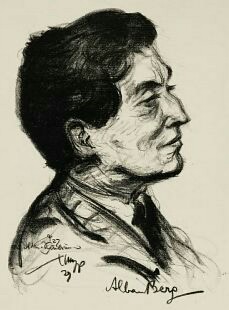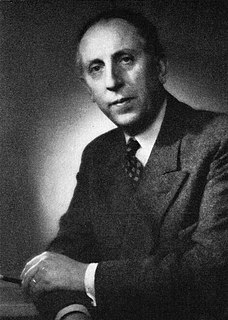Related Research Articles

Karl Amadeus Hartmann was a German composer. Sometimes described as the greatest German symphonist of the 20th century, he is now largely overlooked, particularly in English-speaking countries.

Alban Berg's Violin Concerto was written in 1935. It is probably Berg's best-known and most frequently performed instrumental piece, in which the composer sought to reconcile diatonicism and dodecaphony. The work was commissioned by Louis Krasner, and dedicated by Berg to "the memory of an angel", Manon Gropius. It was the last work that Berg completed. Krasner performed the solo part in the premiere at the Palau de la Música Catalana, Barcelona, on 19 April 1936, after the composer's death.
Karl Richter was a German conductor, choirmaster, organist, pianist and harpsichordist.

Wolfgang Eduard Schneiderhan was an Austrian classical violinist.

Hermann Scherchen was a German conductor.
Karl Ristenpart was a German conductor.

Hilding Constantin Rosenberg was a Swedish composer and conductor. He is commonly regarded as the first Swedish modernist composer, and one of the most influential figures in 20th-century classical music in Sweden.

Hans Rosbaud was an Austrian conductor, particularly associated with the music of the twentieth century.
Susanne Lautenbacher is a German violinist. She studied violin with the Munich-based violin pedagogue Karl Freund and later with Henryk Szeryng. She was a prizewinner in the early years of the Munich ARD Violin Competition. On some early recordings her name appears as Suzanne or Susi.

Freiburger Barockorchester is a German Baroque orchestra founded in 1987, with the mission statement: "to enliven the world of Baroque music with new sounds".
Johannes Paul Thilman was a German composer.
Nikolai Petrovich Rakov, was a Soviet violinist, composer, conductor, and academic at the Moscow Conservatory where he had studied. He composed mostly instrumental works, for orchestra, chamber music and piano music, especially pedagogic works. In 1946, he received the Stalin Prize for his first violin concerto, which became known internationally.
Nino Sanzogno was an Italian conductor and composer.
Trauermusik is a suite for viola and string orchestra, written on 21 January 1936 by Paul Hindemith at very short notice in memory of King George V of the United Kingdom, who died the previous night. The title means "Mourning Music" or "Funeral Music" in English, but the work is always known by its German title.

Kammermusik is the title for eight chamber music compositions by Paul Hindemith. He wrote them, each in several movements, during the 1920s. They are grouped in three opus numbers: Op. 24, Op. 36 and Op. 46. Six of these works, Kammermusik Nos. 2–7, are not what is normally considered chamber music – music for a few players with equally important parts such as a wind quintet – but rather concertos for a soloist and chamber orchestra. They are concertos for piano, cello, violin, viola, viola d'amore and organ. The works, for different ensembles, were premiered at different locations and times. The composer was the soloist in the premiere of the viola concertos, while his brother Rudolf Hindemith was the soloist in the premiere of the cello concerto. Kammermusik is reminiscent of Bach's Brandenburg Concertos, also concertos for different solo and orchestra instruments, and in a neo-Bachian spirit of structure, polyphony and stability of motion.

The Munich Chamber Orchestra is a German chamber orchestra based in Munich. Its primary concert venue is the Prinzregententheater, Munich. The MKO also gives concerts in Munich at such venues as the Pinakothek der Moderne and the Schwere Reiter, and at the Muffathalle during the Munich Biennale.
Gerhard Präsent is an Austrian composer, conductor and academic teacher.

Patricia Kopatchinskaja is a Moldovan-Austrian-Swiss violinist.
Wolfgang Marschner was a German violinist, teacher of violin, composer and conductor. He was concertmaster of the WDR Sinfonieorchester Köln, and instrumental in world premieres of contemporary music. He was professor at the Folkwang-Hochschule Essen, the Musikhochschule Köln, the Tokyo University of Fine Arts and Music and, for more than three decades, at the Hochschule für Musik Freiburg. He also taught at the Darmstädter Ferienkurse.

Vladimir Mikhailovich Genin is a Russian-German composer, pianist and piano teacher. Since 1997 he lives in Munich.
References
- ↑ Rickards, Guy (1995) Hindemith, Hartmann and Henze, Phaidon ISBN 0-7148-3174-3
- ↑ "Liederbuch der Sozialistischen Jugend - die Falken im Kreisverband Bad Doberan". Archived from the original on 2013-10-28. Retrieved 2012-03-11.
- ↑ "Lyrics: Вы жертвою пали (Vy zhertvoiu pali) / You fell victims".
- ↑ available on CD Brüder, zur Sonne, zur Freiheit - Arbeitermusik in der Weimarer Republik in Originalaufnahmen. Dortmund, Edition Pläne nr. 88775
- ↑ Quoted in liner notes to Orfeo CD C718 071 B, trans. Stewart Spencer
- ↑ Liner notes to Hyperion CDA67547.